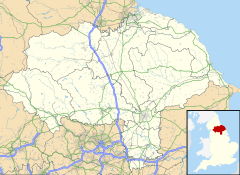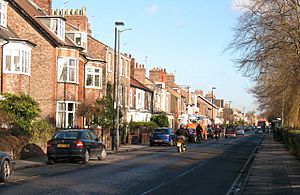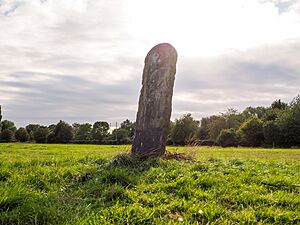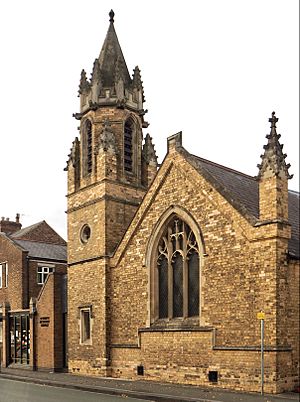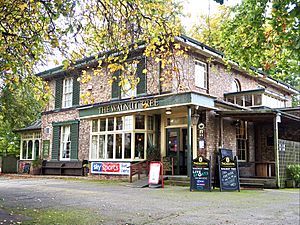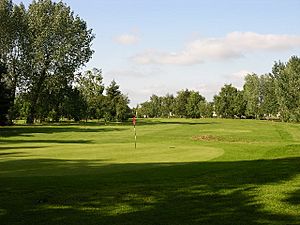Heworth, York facts for kids
Quick facts for kids Heworth |
|
|---|---|
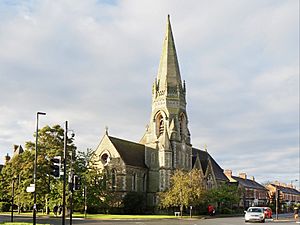 Holy Trinity Church, Heworth |
|
| Population | 13,725 (2011 census) |
| OS grid reference | SE619530 |
| Unitary authority | |
| Ceremonial county | |
| Region | |
| Country | England |
| Sovereign state | United Kingdom |
| Post town | YORK |
| Postcode district | YO31 |
| Dialling code | 01904 |
| Police | North Yorkshire |
| Fire | North Yorkshire |
| Ambulance | Yorkshire |
| EU Parliament | Yorkshire and the Humber |
| UK Parliament |
|
Heworth is a part of the historic city of York in North Yorkshire, England. It is located about 1 mile (1.6 km) north-east of the city centre. While it used to be a village, today "Heworth Village" is the name of a specific road. The name "Heworth" comes from an old Anglo-Saxon word meaning a "high enclosure."
Contents
Living in Heworth
Heworth has many different types of homes. You can find terraced houses, large Victorian houses, and older homes in the original Heworth village. There are also newer semi-detached houses built in the 1930s.
Many new homes have been built in Heworth, especially in the area called Heworth Without.
For local elections, Heworth is divided into two areas: Heworth (which is inside the old city boundary) and Heworth Without (which is outside). Heworth Holme is a popular open space near Heworth village where people can relax.
In 2011, the population of the Heworth area was 13,725 people.
Getting Around Heworth
Heworth is served by several bus routes, making it easy to travel around. These buses are run by companies like First York and East Yorkshire.
The area is also quite close to York station, which is about 1.5 miles (2.4 km) away. From there, you can catch trains to many places across the UK.
Heworth's Past
Not much is known about Heworth before recorded history. Some experts think the area was once very wet and marshy. However, it has Roman roots. Two Roman burial grounds have been discovered here. Heworth Green, a road leading from York city centre, follows the path of an old Roman road.
During the early Medieval period (around the 5th and 6th centuries), people were buried in similar areas to the Roman graves. But there isn't much evidence of settlements from this time.
Heworth is mentioned in the Domesday Book of 1086 as Heworde. Later, in 1219, it was called Hewud.
Heworth used to be a small local area called a township. In 1866, it became its own civil parish. Then, in 1894, it was divided. The part within the city of York became Heworth Within, and the rural part became Heworth Without. In 1891, the parish had 740 residents.
The Battle of Heworth Moor (1453)
On August 24, 1453, a fight happened on Heworth Moor. This event was the first clash between two powerful families, the Percy and Neville families. Their rivalry eventually helped start the Wars of the Roses, a series of civil wars in England.
Historians say that Lord Egremont attacked the Neville family's wedding party. Many people at the time saw this as the very first military action of the Wars of the Roses.
The Neville family was returning to their castle after a wedding. The bride was Maud Stanhope, who was set to inherit land that Lord Egremont wanted. He was very angry about this.
So, Lord Egremont and about 1,000 of his followers from York ambushed the Nevilles at Heworth Moor. The Neville family fought bravely and defended themselves well in the skirmish.
The Meeting on Heworth Moor (1642)
In the summer of 1642, before the English Civil War began, King Charles I and Parliament were trying to negotiate. At the same time, both sides were getting ready for war.
King Charles I wanted to gather a personal guard in York. This guard was secretly meant to become the start of his army. Parliament asked Lord Fairfax to give the King a petition. This petition asked the King to listen to Parliament and stop raising troops.
This happened at a large meeting of landowners and farmers from Yorkshire on Heworth Moor on June 3, 1642. The King tried to avoid taking the petition by riding his horse forward. But Thomas Fairfax bravely followed him and placed the petition right on the King's saddle.
Heworth's Growth
Around 1817, construction began on the Heworth Green Villas along Heworth Road. Until the mid-1800s, the local leader of Heworth was Reverend Robert William Bilton Hornby. An old map from 1849 shows that Heworth was mainly a square of three streets between Scarborough Road and East Parade.
On the edge of the village, near Monk Stray, was Elmfield College. This was a school that existed from 1864 to 1932. Today, only a few buildings remain from the college.
Holy Trinity Church was built in 1869. Other important buildings at the time included a Methodist Chapel, the manor house, a pub called The Britannia, and several potteries. Tang Hall was once just a large house in a park, but it has since grown into its own neighborhood. Christ Church was built on Stockton Lane in 1964. Heworth was recognized as a special "Conservation Area" in 1975 to protect its unique character.
Famous People from Heworth
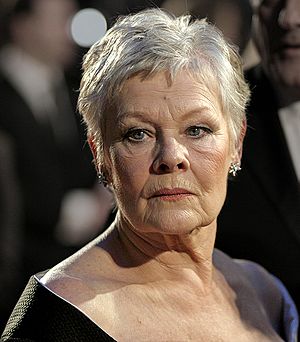
- Mary Ward (1585–1645) was a Roman Catholic nun. She founded the Sisters of Loreto. She moved to Heworth in 1643. During the dangers of the English Civil War, she had to move into York city. She later returned to Heworth and died there in 1645. She is buried in Osbaldwick Churchyard.
- Barbara Ward (1914–1981) was an economist and writer. She was very interested in developing countries and the environment. She was given the title of Dame Commander of the Order of the British Empire.
- Dame Judi Dench is a famous actress who was born in Heworth Green.
- Robert William Bilton Hornby was a priest and historian. He was also the Lord of the Manor of Heworth.
- Alan Leach is the drummer from the band Shed Seven.
Important Buildings
- Heworth Manor (also called the Old Manor House or Heworth Hall) used to be at the corner of Heworth Village and Walney Road, but it has been torn down. It was once owned by the Catholic Thwenge/Thwing family. The Catholic nun Mary Ward is said to have died here. The house was a secret meeting place for Catholics during a time when their religion was not allowed.
- The Cottage, at 11 Stockton Lane, was built around 1800. It is a charming house with a unique door frame from the mid-1700s.
- The Manor House, at 1 Stockton Lane, was built before 1830. It is an unusual, almost cube-shaped house, partly two and partly three stories tall.
- Rose Villa, at 32/34 Stockton Lane, was built in the early 1800s. It is a double-fronted house with additions made later.
- The old Elmfield College (built in the 1840s) still has one building standing on Straylands Grove.
- Heworth House in Melrosegate was built in 1865. It was designed as the old Heworth Rectory (a house for a priest). It shows the grand style of Victorian Gothic architecture.
- Holy Trinity Church, built in 1869, was also designed by G. Fowler Jones.
Sports in Heworth
Heworth has a long history in sports like cricket, football, and rugby league. The Heworth Cricket Club is believed to have started in 1784.
The local football club was one of the first to play in the York area, joining the York Football League in 1898. They were runners-up in the top league several times in the early 1900s.
Elmpark Way in Heworth has hosted the York International 9s competition since 2002. This is an annual rugby league nines tournament. Teams from England, France, and Russia have competed here in the past. It has even received a high rating from the Rugby League European Federation.


